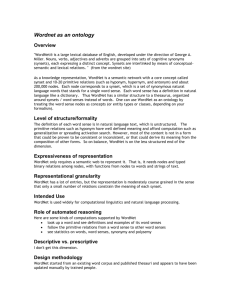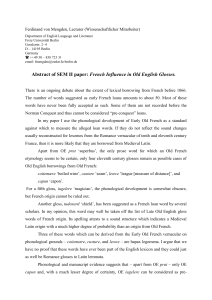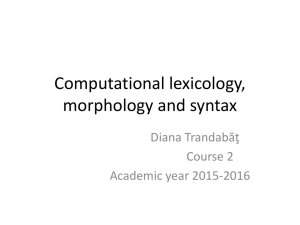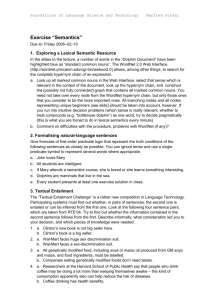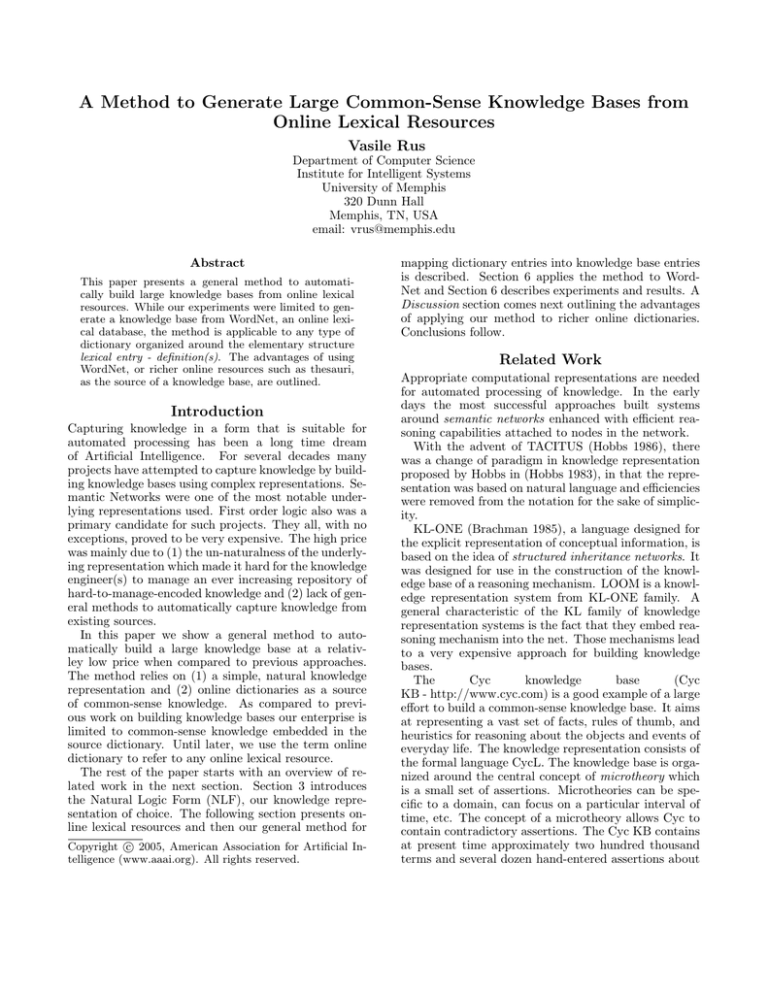
A Method to Generate Large Common-Sense Knowledge Bases from
Online Lexical Resources
Vasile Rus
Department of Computer Science
Institute for Intelligent Systems
University of Memphis
320 Dunn Hall
Memphis, TN, USA
email: vrus@memphis.edu
Abstract
This paper presents a general method to automatically build large knowledge bases from online lexical
resources. While our experiments were limited to generate a knowledge base from WordNet, an online lexical database, the method is applicable to any type of
dictionary organized around the elementary structure
lexical entry - definition(s). The advantages of using
WordNet, or richer online resources such as thesauri,
as the source of a knowledge base, are outlined.
Introduction
Capturing knowledge in a form that is suitable for
automated processing has been a long time dream
of Artificial Intelligence. For several decades many
projects have attempted to capture knowledge by building knowledge bases using complex representations. Semantic Networks were one of the most notable underlying representations used. First order logic also was a
primary candidate for such projects. They all, with no
exceptions, proved to be very expensive. The high price
was mainly due to (1) the un-naturalness of the underlying representation which made it hard for the knowledge
engineer(s) to manage an ever increasing repository of
hard-to-manage-encoded knowledge and (2) lack of general methods to automatically capture knowledge from
existing sources.
In this paper we show a general method to automatically build a large knowledge base at a relativley low price when compared to previous approaches.
The method relies on (1) a simple, natural knowledge
representation and (2) online dictionaries as a source
of common-sense knowledge. As compared to previous work on building knowledge bases our enterprise is
limited to common-sense knowledge embedded in the
source dictionary. Until later, we use the term online
dictionary to refer to any online lexical resource.
The rest of the paper starts with an overview of related work in the next section. Section 3 introduces
the Natural Logic Form (NLF), our knowledge representation of choice. The following section presents online lexical resources and then our general method for
c 2005, American Association for Artificial InCopyright telligence (www.aaai.org). All rights reserved.
mapping dictionary entries into knowledge base entries
is described. Section 6 applies the method to WordNet and Section 6 describes experiments and results. A
Discussion section comes next outlining the advantages
of applying our method to richer online dictionaries.
Conclusions follow.
Related Work
Appropriate computational representations are needed
for automated processing of knowledge. In the early
days the most successful approaches built systems
around semantic networks enhanced with efficient reasoning capabilities attached to nodes in the network.
With the advent of TACITUS (Hobbs 1986), there
was a change of paradigm in knowledge representation
proposed by Hobbs in (Hobbs 1983), in that the representation was based on natural language and efficiencies
were removed from the notation for the sake of simplicity.
KL-ONE (Brachman 1985), a language designed for
the explicit representation of conceptual information, is
based on the idea of structured inheritance networks. It
was designed for use in the construction of the knowledge base of a reasoning mechanism. LOOM is a knowledge representation system from KL-ONE family. A
general characteristic of the KL family of knowledge
representation systems is the fact that they embed reasoning mechanism into the net. Those mechanisms lead
to a very expensive approach for building knowledge
bases.
The
Cyc
knowledge
base
(Cyc
KB - http://www.cyc.com) is a good example of a large
effort to build a common-sense knowledge base. It aims
at representing a vast set of facts, rules of thumb, and
heuristics for reasoning about the objects and events of
everyday life. The knowledge representation consists of
the formal language CycL. The knowledge base is organized around the central concept of microtheory which
is a small set of assertions. Microtheories can be specific to a domain, can focus on a particular interval of
time, etc. The concept of a microtheory allows Cyc to
contain contradictory assertions. The Cyc KB contains
at present time approximately two hundred thousand
terms and several dozen hand-entered assertions about
each term. New assertions are continually added to the
KB by human knowledge engineers.
START is a Question Answering system developed at
MIT by Katz (Katz 1997). Given an English sentence
containing various relative clauses, appositions, multiple levels of embedding, the START system first breaks
it up into smaller units, called kernel sentences (usually
containing one verb). Following a separate analysis of
each kernel sentence, START rearranges the elements of
all parse trees it constructs into a set of embedded representational structures. These structures are made up
of a number of fields corresponding to various syntactic parameters in a sentence, but the three most salient
parameters, the subject of a sentence, the object, and
the relation between them are singled out as playing a
special role in indexing. These parameters are explicitly represented in a discrimination network for efficient
retrieval.
All previously mentioned systems (except START)
attach procedures to nodes in an underlying semantic
network. As Hobbs pointed out in (Hobbs 1983) “decoupling the details of implementation, as efficiencies
and procedures, from the representation itself would
allow to focus on the real problems at hand: in natural language that is interpretation of discourse”. This
philosophy was used in TACITUS (Hobbs 1986).
TACITUS was a project for interpreting text. Its underlying representation consists of first-order predicate
calculus obtained through a large coverage syntactic
and semantic translator DIALOGIC, which is an extension of DIAGRAM (Robinson 1982). The main advantage of the representation was simplicity, allowing the
researcher to focus on the real problems of text interpretation. DIALOGIC produces a logical form in firstorder predicate calculus by encoding everything that
can be determined by purely syntactic means, without recourse to context or world knowledge. The advent of TACITUS (Hobbs 1986) produced a change of
paradigm in knowledge representation, which started to
be visible in the START project, in that the representation was based on natural language and efficiencies were
removed from the notation for the sake of simplicity.
Advantages of Natural Language Based
Knowledge Representations (KR)
Among the advantages of building NL-based KR systems, as outlined at the first Workshop on Knowledge
Representation Systems based on Natural Language
(1996 AAAI Fall Symposium), are:
• NL-based systems would be user friendly
• Most human knowledge is encoded and transmitted
via natural language and thus NL-based KR are a
natural development
• Searching on the Internet has become a necessity and
a daily task for most of us. Natural language is heavily used in this task since more than 90% of the web
information is textual
• NL-based knowledge processing sytems would provide a uniform symbolic representation for encoding
knowledge and processing
• it it is hard to match expressiveness of natural language, particularly in not (well) formalized domains
Recent advances of Natural Language Processing
(NLP) in the areas of syntactic parsing, semantics and
pragmatics have opened new perspectives for developing expressive KR and building promising NL-based
knowledge processing systems.
Our natural language based knowledge representation is the Natural Logic Form. The next section describes in detail the principles standing behind the Natural Logic Form representation. We focus on the syntactic information of predicates, i.e. subject, direct object and others. The implementation approach and details of how to derive logic forms are described in later
sections.
The Knowledge Representation
The knowledge representation of choice when building
a knowledge base has an impact in all the aspects of the
development. We guided our choice by two principles.
First, the representation should be close enough to natural language in order to allow us to capture already existing knowledge in textual form. Second, the representation should be close to a logic that is well-understood
and has well-defined inference procedures. The Natural Logic Form, a natural language based knowledge
representation, seems to best fit our principles.
NLF is first order, syntactically simple, logic and
it improves over similar representations used in many
language processing applications. Davidson (Davidson
1967) proposed the predicate treatment of verbs and
then Hobbs (Hobbs 1983) applied this concept to automated text processing, particularly interpretation of
texts. Moldovan and Rus (Moldovan & Rus 2001) proposed a similar representation and used it to Question
Answering to search answers that were not explicitly
stated in supporting documents.
An example of how an English sentence is mapped
onto NLF is illustrated for the following sentence:
The Earth provides the food we eat every day.
Its corresponding natural logic form (NLF) is:
Earth:n (x1) & provide:v (e1, x1, x2) &
food:n (x2) & we:n (x3) & eat:v (e2, x3, x2;
x4) & every:a (x4) & day:n (x4)
In NLF a predicate is generated for every noun, verb,
adjective or adverb. The name of the predicate is a
concatenation of the word’s base form and its part-ofspeech. In the example given above, the verb provides
is mapped onto the predicate provide:v, where provide
is the base form for provides and v stands for verb (the
part of speech for provide). Arguments for predicates
are of two types: e - for events specified by verbs, respectively x - for entities. Verb tenses and plurals are
ignored similar to (Moldovan & Rus 2001). The LF of
the entire sentence is the conjunction of individual predicates. Sentences are considered individually, ignoring
for the time being discourse issues such as coreference
resolution.
The argument’s position is also important as it encodes syntactic information: the second argument for a
verb is syntactic subject, the third is direct object and
the fourth is indirect object. For instance, the second
argument of the predicate provide:v (e1, x1, x2) is x1
(Earth), the subject of the providing event. Arguments
after semicolon, ’;’, are adjuncts (arguments related to
time and space which are not mandatory to convey the
meaning of a utterance).
NLF has several advantages over similar notations
(Montague style semantics, Description Grammars,
previous Logic Forms, etc.):
• NLF allows a simple syntax/semantics interface;
• NLF is user friendly - easily readable by new users
and thus no special training is needed;
• NLF uses concept predicates, resulting in a less ambiguous representation;
• NLF has positional syntactic information that ease
other language processing tasks such as textual inference and
• NLF distinguishes between arguments and adjuncts
which makes it different from previous representations and more expressive. Argument x4 of predicate
eat in the example is an adjunct since it hints the
time of the eating event and is placed after ’;’ in the
argument list
Once you decided on your KR of choice you can build
a knowledge base either manually (see Cyc project) or
automatically. The automated option needs a source of
knowledge and an automated method to map the source
into a knowledge base. In this work, our source(s) are
online dictionaries described in the next section. The
automated method is presented in Section 5.
Online Lexical Resources
We use the term online lexical resource to denote electronic versions of the following three categories: classical dictionaries (Webster’s, Oxford’s, etc.), thesauri
(Roget’s) and lexical databases (WordNet). The three
categories share the common property of being organized around the elementary structure word/concept definition that constitute an entry in the dictionary.
Roget’s thesaurus and WordNet have a richer organization of those entries than the simpler lexicographical
listing that is used in classical dictionaries.
Dictionaries are a rich source of common sense knowledge since they contain the major concepts (together
with their definitions and usage) that people use to
understand and reason about the surrounding world.
People use them frequently to improve their daily experience of life.
The advent of online versions of traditional dictionaries has opened new posibilities of exploiting their rich
content in AI applications. For example, Morris and
Hirst (Morris & Hirst 1991) did not implement their
algorithm, because there was no machine-readable version or Roget’s Thesaurus at that time.
Roget’s International Thesaurus, 4th Edition (1977)
is composed of 1042 sequentially numbered basic categories. A thesaurus simply groups related words without attempting to explicitly name each relationship.
WordNet is an electronic lexical database developed
at Princeton University based on linguistic principles.
It is divided into four data files containing data for
nouns, verbs, adjectives and adverbs. In WordNet the
basic unit is a synset - a set of synonymous words which
refer to a common semantic concept. Words may be
formed in more than one synset: the noun chocolate
belongs to three different synsets as given in Table 1.
The first sense of each word in WordNet is the most
frequent sense.
A small textual definition is attached to each synset
via a gloss relation. An example is also included in the
gloss for the large majority of synsets. Table 1 shows
a few synsets with their corresponding glosses. WordNet 2.0 contains 115,424 synsets and 152,059 unique
words. A list of pointers is attached to each synset
and these pointers express relations between synsets.
The most important relation is the hypernymy relation. Noun and verb synsets are hierarchically organized based on the hypernymy relation. For example the synset {professor} is a hyponym of the synset
{academician, academic, faculty member}. In other
words, there is a hypernymy relation from the former
synset pointing to the latter, and a hyponymy relation
in the form of a pointer from the latter synset to the former. Adjectives and adverbs are organized in clusters
based on similarity and antonymy relations.
Since dictionary entries’ definitions are encoded in
plain English it is necessary to transform them into
a more computational form that can be processed by
other AI tools that require common sense knowledge.
The underlying computational representation in this
paper is the Natural Logic Form, a first-order, natural
language based knowledge representation that contains
lexical, categorial, syntactic and semantic information.
In this paper we show how dictionary entries can be
transformed into world axioms which altogether form a
highly inter-connected knowledge base.
Method
Our method takes as input an entry in an online lexical
resource and maps it into one or more entries in the
knowledge base.
The major steps needed are outlined below.
• extract alternative definitions using explicit markers
and exploiting linguistic parallelism cued by conjunctions
Table 1: WordNet 2.0 synsets for word form chocolate
Synset
{cocoa, chocolate,
hot chocolate,
drinking chocolate}
{chocolate}
{chocolate, coffee, deep
brown, umber, burnt umber}
• tokenize the definition, i.e.
punctuation
Gloss
(a beverage made from cocoa powder
and milk and sugar)
(a food made from roasted ground cacao beans)
(a medium to dark brown color)
separate words from
• expand the definition to full sentence using a technique detailed in the next section
• parse the sentence
• extract the NLF
• propagate arguments from left hand side to right
hand side
• generate axiom(s)
In any lexical resource, an entry, be it a word or a concept (set of words with common meaning), has one or
more definitions attached to it. Those definitions are
in the form of an incomplete sentence. To compensate
for the tendency of syntactic parsers to build sentence
structures for any given input, our solution is to expand
the original definitions of entries.
We give here the algorithm presented to expand entries to full sentences for the case of WordNet definitions, called glosses. Glosses are expanded to full sentences using several patterns as described below.
1. For noun glosses, add the first word of the synset,
followed by a “be” verb. For example, the definition
of {prophet, oracle} becomes Prophet is an authoritative person who divines the future.
2. For verb glosses, add to “verb” is to to each gloss
definition. Example: the definition of {divine} with
sense 1 becomes To divine is to perceive intuitively
or through some inexplicable perceptive powe rs.
3. For adjective glosses, add it is something to each definition. Example: The definition of {authoritative,
important} becomes It is something having authority
or ascendancy or influence.
4. For adverb glosses, add it means to each definition.
For example: the gloss of {intuitively} is extended to
It means in an intuitive manner.
Although the above patterns are sufficient for most
of the cases, a few alternatives are used. For example
for noun glosses we use the following alternatives: (1)
If noun gloss begins with MD1 or VBZ add only noun
1
The meaning of the tags for parts of speech are: MD modal verb, VBZ - 3rd person singular present, VBN - past
participle, RB - adverb, IN - preposition, NNS - common
noun plural, NNPS - proper noun plural
as in “Noun performs simple arithmetic functions” or
“Noun can be changed to different settings” (2) If the
gloss begins with RB, VBN, where, IN add noun is
something as in “ Noun is something designed to serve
a specific function .“ (3) If the gloss begins with plurals
NNS, NNPS add Nouns are as in “ Nouns are projectiles
to be fired from a gun”.
The improvement in parsing accuracy obtained by
these expansion techniques can be significant: from
59.77% accuracy on 2,000 raw glosses to 82.25% accuracy on expanded glosses.
Application to WordNet
The previous method can be applied easily to WordNet.
One or more axioms are generated from a synset-gloss
pair, where the synset is the elementary entry in WordNet and the gloss is the definition of that entry.
The steps of the method as adapted to WordNet are
outlined below.
• extract alternative definition for the same entry. In
WordNet the end of a definition is marked by “;”.
• tokenize the definition(s)
• expand the definition(s) to full sentences as described
in the previous section
• use a part-of-speech tagger and a parser to obtain a
structural view of the sentences. We use Eric Brill’s
tagger (Brill 1992) and flavors of Michael Collin’s
(Collins 1997) parser to obtain syntactic trees for the
expanded definition(s)
• generate the natural logic form using structural information embedded in the parse trees. We use an
argument-centric approach which given an argument
slot for a predicate it predicts the most probable
candidate for the slot. We map the argument assignment task into a classification task and use a
naive Bayes model to build the classifier. Classifiers are programs that assign a class from a predefined set to an instance or case under consideration
based on the values of attributes used to describe
this instance. Naive Bayes classifiers use a probabilistic approach, i.e. they try to compute a conditional distribution of classes and then predict the
most probable class. To acquire the distributions we
use Treebank (Marcus, Santorini, & Marcinkiewicz
1993) ’s, a collection of English text expert-annotated
with structural information. The Wall Street Journal part contains functional tags in its annotation
besides basic phrases such as noun phrase (NP), verb
phrase (VP), etc. Those tags were necessary to distinguish words or phrases that belong to one syntactic category and is used for some other function or
when it plays a role that is not easily identified without special annotation. In our model we used a set
of attributes/features similar to (Blaheta & Johnson
2000) that includes the following: label, parent’s label, right sibling label, left sibling label, parent’s head
pos, head’s pos, grandparent’s head’s pos, parent’s
head, head. We did not use the alternative head’s pos
and alternative head (for prepositional phrases that
would be the head of the prepositional object) as explicit features but rather we modified the head rules
so that the same effect is obtained but in our model
is captured in pos and head features, respectively. A
simple add-one smoothing method was used. Local
dependencies inside a phrase are treated as modifiermodifee relations with the modifee being the head of
the phrase.
• propagate arguments from the entry to the definition
as described in the rest of this section
• from the logic form and the entry generate entries in
the knowledge base. Each such entry can be viewed
as an axiom.
A {synset - definition} pair can be viewed as an axiom of the underlying concept. For each such pair one or
more axioms can be generated: (1) a fact (no left hand
side) for synsets with empty definitions (2) a single axiom for the usual gloss (3) many axioms - for definitions
that exhibit linguistic parallelism.
There are some specific aspects in the derivation of
axioms for each part of speech. Usually a noun definition consists of genus and differentia. The template for
deriving noun axioms is: concept(x) → genus(x) & differentia(x). Notice the propagation of arguments from
the left hand side to the genus and differentia, without
significant syntactic changes.
The verbs also exhibit the same structural properties
and the derivation is simple for the case of definitions
containing only one verb. In the case of definitions consisting of a series of verbs, the derivation of axioms
should take care of the syntactic functional changes of
the arguments on the right hand side from their counterparts on the left hand side.
Consider veto:v#1 → {“vote against”}. The axiom
is veto:v#1(e, x, y) → vote(e1, x, y) & against(e1, y).
One notices the change of y from a direct object role for
veto to a prepositional object role for vote. Also event
e expands in two other events e1, e2 for the second and
third axiom in Table 3.
In
the
case
of
adjectives
which modify nouns, the axioms borrow a virtual head
noun as shown here: American:a#1(x1) → of(x1, x2) &
United States of America(x2). Similarly, since adverbs
modify verbs - their arguments borrow the event of the
verb. Adverb fast:r#1 has this corresponding axiom:
fast:r#1(e) → quickly(e).
Experiments and Results
To validate our procedure we made an experiment on a
subset of WordNet 2.0 noun glosses.
We focused on 2,000 entries to be transformed onto
axioms. We extracted the corresponding glosses from
the WordNet database and for each entry we detected
2,267 definitions. The definitions are then tokenized,
expanded into full sentences using the expansion algorithm, part-of-speech tagged and parsed.
The next phase is to generate the logic form. It starts
with generating predicates and main arguments for content words that are heads of major phrases. Modifiers
of the head words share the argument with the head and
are processed next. Then, simple relation predicates are
processed such as prepositions, conjunctions etc. More
complex predicates, mainly verbs, are processed at last.
Their arguments are obtained using a naive Bayes classifier able to select the most probable candidate for a
functional role such as logical subject. The classifier
is induced using a data set induced from sections 1-21
of Wall Street Journal (WSJ) part of Penn Treebank.
The set of attributes/features, presented in the previous section, was automatically extracted from trees together with their classification. In those experiments
punctuation was mapped to a unique tag PUNCT and
traces 2 were replaced with TRACE.
Two performance measures are reported from (Rus
2002). Each is more useful than the other in some context.
First, we define predicate level performance as the
number of predicates with correct arguments divided
by the total number of predicates. This measure gives
a finer-grained look at the derivation process and illustrates the power of a method without considering the
application which uses the glosses.
Gloss level performance is defined as the number
of full glosses correctly transformed into logic forms
divided by the total number of glosses attempted.
This new measure catches contextual capabilities of a
method in that it gives an idea of how well a method
performs at gloss level. It is a more appropriate measure
when one tries to see the impact of using full glosses in
logic forms to applications such as planning.
On the test set of 2000 glosses we report a performance of 84.9% and 93.2% at gloss and predicate level,
respectively.
Except the naive Bayes model induction which require few weeks of development the axiom generation
process is fast. For the 2,267 definitions, the axioms
were generated in less than half an hour on a regular
desktop computer running Linux.
2
Traces are artificial links introduced in Treebank
to accomodate the bracketed representation to remote
dependencies.
Table 2: Axioms extracted from the gloss of adjective Romanian:a#1
Romanian(x1)
Romanian(x1)
Romanian(x1)
Romanian(x1)
Romanian(x1)
Romanian(x1)
Romanian(x1)
Romanian(x1)
Romanian(x1)
↔
↔
↔
↔
↔
↔
↔
↔
↔
of(x1, x2) & country(x2) & of(x2, x3) & Romania(x3)
of(x1, x2) & people(x2) & of(x2, x3) & Romania(x3)
of(x1, x2) & language(x2) & of(x2, x3) & Romania(x3)
relate(e1, x1, x2) & country(x2) & of(x2, x3) & Romania(x3)
relate(e1, x1, x2) & people(x2) & of(x2, x3) & Romania(x3)
relate(e1, x1, x2) & language(x2) & of(x2, x3) & Romania(x3)
characteristic of(x1, x2) & country(x2) & of(x2, x3) & Romania(x3)
characteristic of(x1, x2) & people(x2) & of(x2, x3) & Romania(x3)
characteristic of(x1, x2) & language(x2) & of(x2, x3) & Romania(x3)
Table 3: Axioms extracted from the gloss of verb veto:v#1
veto:v#1(e, x, y) ↔ vote(e1, x, y) & against(e1, y)
veto:v#1(e, x, y) ↔ refuse(e1, x, e2) & to(e1, e2) & endorse(e2, x, y)
veto:v#1(e, x, y) ↔ refuse(e1, x, e2) & to(e1, e2) & assent(e2, x, y)
Discussion
We showed in the previous sections how our method of
mapping online lexical resources entries onto knowledge
base entries can be applied to WordNet. The method
can also be applied to any other regular dictionary or
thesaurus, such as Roget’s. The advantage of applying the method to WordNet, or richer lexical resources
than classical dictionaries, is that once you generated
the knowledge base entries, you can import from the
original resource the rich lexico-semantic relations already available there. For example, for WordNet, once
you generated axioms for abbey, you have it linked to
axioms for its hypernym (superconcept) or hypenyms
(subconcepts) and many others. This can be of substantial use in later processing. For a regular dictionary the generated knowledge base is a list of axioms
lexicographically ordered. Any use of an axiom may be
accompanied by an expensive search.
Conclusions
We presented in this paper a general method to map
online lexical resources onto a knowledge base having
a natural language based knowledge representation as
its underlying coding language. While our experiments
were limited to a small part of WordNet they can be
easily applied to other resources. The advantages of
our method can be summarized as this: (1) it uses a
natural language based knowledge representation that
makes the management much easier (2) it allows the
aqcuisition of knowledge from textual form where most
of the knowledge is already available.
References
Blaheta, D., and Johnson, M. 2000. Assigning function
tags to parsed text. In Proceedings of the 1st Annual
Meeting of the North American Chapter of the Association for Computational Linguistics, Seattle, May
2000, pp. 234-240.
Brachman, R. 1985. An overview of the KL-ONE
knowledge representation system. Cognitive Science
(9):171–216.
Brill, E. 1992. A simple rule-based part of speech tagger. In Proceedings of the Third Conference on Applied
Natural Language Processing, 152–155.
Collins, M. 1997. Three generative, lexicalised models for statistical parsing. In Proceedings of the 35th
Annual Meeting of the ACL.
Davidson, D. 1967. The logical form of action sentences. In Rescher, N., ed., The Logic of Decision and
Action. University of Pittsburgh Press. 81–95.
Hobbs, J. 1983. Ontological promiscuity. In Proceedings 23rd Annual Meeting of the ACL, 57–63.
Hobbs, J. R. 1986. Overview of the TACITUS project.
Computational Linquistics 12(3).
Katz, B. 1997. From sentence processing to information access on the world wide web. In AAAI., ed.,
Proceedings of AAAI Spring Symposium on Natural
Language Processing for the World Wide Web.
Marcus, M.; Santorini, B.; and Marcinkiewicz. 1993.
Building a large annotated coprus of english: the penn
treebank. Computational Linguistic 19(2):313–330.
Moldovan, D. I., and Rus, V. 2001. Logic Form transformation of wordNet and its Applicability to Question
Answering. In Proceedings of ACL 2001. Toulouse,
France: Association for Computational Linguistics.
Morris, J., and Hirst, G. 1991. Lexical cohesion computed by thesaural relations as an indicator of the
structure of text. Computational Linguistics 17(1):21–
43.
Robinson, J. 1982. DIAGRAM: A grammar for dialogues. Communications of the ACM 25(1):27–47.
Rus, V. 2002. High precision logic form transformation. In International Journal for Tools with Artificial
Intelligence. IEEE Computer Society.



